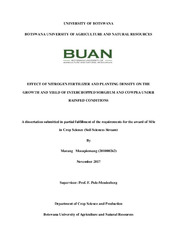| dc.description.abstract | Cereal-legume intercropping can be an alternative for smallholder farmers to mitigate the effects of climate change and to promote sustainable agricultural production. A field experiment was conducted at BUAN gardens during the 2015/2016 planting season to assess the effect of nitrogen fertilization, planting density and cropping system on the growth, yield and nutrient uptake of sorghum and cowpea. The experiment was arranged in a split-split plot design with five levels (0, 50, 75, 100, 125 kg N/ha) of lime ammonium nitrate (LAN) fertilizer as the main plot (with plants that received 0 kg N/ha being control plants), three cropping systems (sole cowpea, sole sorghum and intercrops) as sub plots and three planting densities (40 000, 53 333 and 66 667 plants/ha) as sub-sub plots. The results have shown that LAN application had little effect on the growth, yield and nutrient uptake of cowpea. The control cowpea plants had significantly (p ≤ 0.01) higher photosynthetic rates irrespective of planting density and cropping system. They also exhibited the highest stomatal conductance, WUE, nodule number, nodule biomass, root and shoot biomass and therefore higher nutrient uptake. Planting at a density of 53 333 plants/ha significantly (p ≤ 0.01) increased photosynthetic rate in cowpea. Intercropped cowpea had significantly lower nodule biomass, lower WUE and increased transpiration rates. Planting cowpea at a higher density of 66 667 plants/ha significantly (p ≤ 0.05) increased its WUE but decreased the uptake of some nutrients. In sorghum N application increased growth, yield and nutrient uptake. Nitrogen application rate of 50 kg/ha increased shoot and root biomass, NUE and nutrient uptake in sorghum. Intercropped sorghum had significantly higher photosynthetic rates and lower NUE than monocropped sorghum. The control sorghum plants showed significantly higher photosynthetic rates with intercropped plants exhibiting higher values. However, there were no significant differences in the yield of sorghum whether it is among the various levels of LAN applications, between the cropping systems or among different planting densities. Similar to sorghum, all treatments did not lead to any increase in the yield of cowpea grain. In conclusion, the 2015/2016 cropping season was not a normal one due to the extreme soil temperature. Thus, increased growth, biomass yield and nutrient uptake in cowpea and sorghum caused by the interaction between LAN application and planting density did not translate to increased grain yields. Intercropping sorghum with cowpea was efficient than monocropping in resource utilization as shown by LER value that is greater than one. It is recommended that more leguminous plants with high nitrogen fixing capability should be included to fix more nitrogen and reduce fertilizer cost by smallholder farmers. Modelling should be included to help policy makers in planning to assist farmers on improving crop production to increase food security in a sustainable manner. | en_US |

